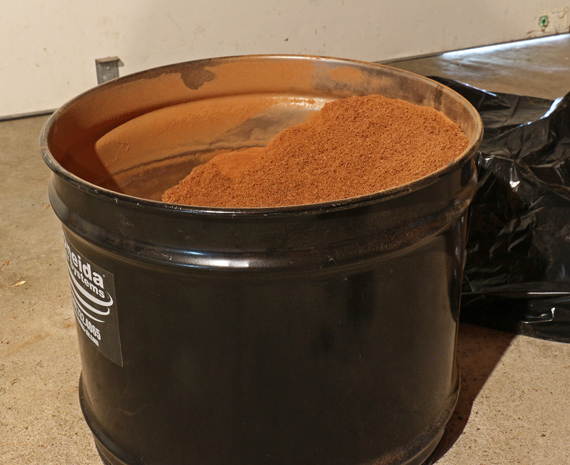
For the 500th post since the inception of this weblog in 2008, I would like to present the Grand Unified Theory of Woodworking. Concocted while emptying my dust collector, this offers deep insight to woodworkers and non-woodworkers alike as to what really goes on in the shop.
And so: You start with a tree. Then, to produce a masterpiece you merely remove the exactly correct tiny pieces of wood (as shown in the dustbin pictured above) while retaining the exactly correct wood in the workpieces, which you then simply join together. Done.
I present this ridiculous notion only to make a couple of points, which are hardly original but bear repeating.
The people who see and use what we make almost never understand the effort, time, skill, and expense required to make high-end woodwork. Perhaps this is only due to the nature of the craft – wood seems so accessible to work. More likely, it is partly or even largely the fault of woodworkers (like me). Most of the things we use in our modern world are made in huge numbers by computer-controlled machinery. In some cases, the consumer’s hands may be the first to ever hold the product. I think woodworkers should affably convey an understanding of what goes into our work to those who encounter it.
Second, we woodworkers are similarly apt to forget that making excellent stuff is really difficult. Not to be whiny, but it is healthy to acknowledge that we are always dealing with some degree of workmanship of risk from which even the gadgetry of modern woodworking does not shield us. As a mostly subtractive process, woodworking can be unforgiving (again, see dustbin). For me at least, I have to remember to go easy on myself, trust my hard-won capabilities, and be always open to improving my skills.
It’s simple, really.


Similar to the old rule about carving a sculpture of a horse. Start with a block of wood and carve away anything that doesn’t look like a horse.
Congratulations on your 500th post.
Randy,
Ha, that’s perfect!
Thanks,
Rob
Hi Rob,
Congratulations on your 500th post! I’ve been reading your blog for the past two or three years now? I hope you will continue writing, since your knowledge is helpful for many of us I’m sure, it has been for me. Your last phrase strikes a chord with me. Thank you.
Thanks, Pascal.
Rob
Rob-
Thanks for all the great ideas. They are helpful and appreciated. Congrats on the 500th. Many more to come.
–Steve.
Thanks, Steve.
Rob
Hi rob,
congratulations on this number! I like this site very much, not only for high quality knowledge, but also for the attitude towards this craft, which sometimes is called philosophy. It is generous of you to share all this, so thank you!
Bernd
Thanks for reading, Bernd.
Rob
Rob —
Just dropping a note to say hello and thank you for your posts. I have been woodworking for about ten years, but only in the last couple have I transitioned to primarily hand tool, solid wood pieces. I only recently discovered your site — what a wealth of knowledge you convey! I am working my way through it, and am particularly struck by the “ideas” category. I don’t think I have run across anything quite like it. So, thanks.
Hi John,
Thanks for reading. I hope the content is helpful.
Rob